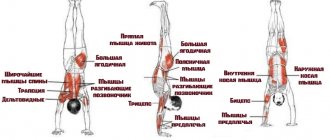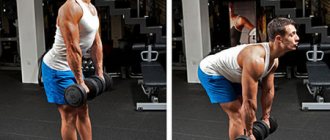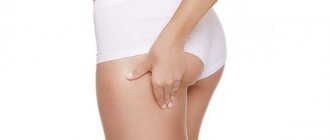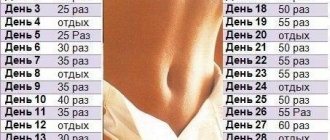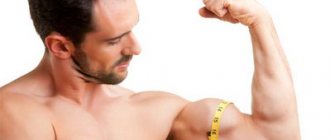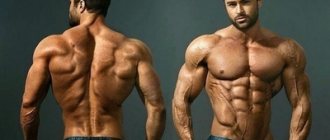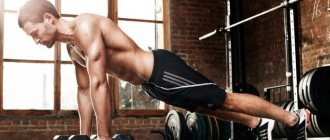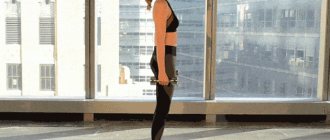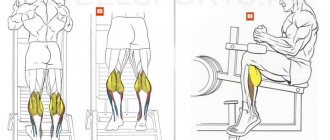How to pump up biceps without dumbbells and barbells at home? This question is the most popular among “green” athletes. Many people who have decided to take the path of a healthy lifestyle are faced with the same problems over and over again: some do not have enough money to sign up for a gym, while others, due to their busy schedule, cannot even find time to do it. physical exercise. Because of such obstacles, most beginning athletes simply abandon this idea and never return to the sport. If these people knew how to pump up biceps without dumbbells and barbells and get other muscle groups in shape without using additional equipment, then they would not be so hasty in giving up healthy lifestyle! This article is devoted to this problem.
Rules and tips
Before you learn how to pump up your arms at home without dumbbells and barbells, you need to familiarize yourself with important recommendations. If you follow all the tips described, you can greatly increase your muscle growth progress!
- You don't need to train your arms too often. Many beginners mistakenly believe that the more often they pump their biceps, the sooner they will grow. This technique leads to overtraining, and in this situation you can completely forget about muscle growth! The arm muscles need to be trained no more than 1-2 times a week so that they have time to recover.
- You don't need to train just your arms. Unfortunately, many novice athletes are only interested in how to pump up their biceps without dumbbells and barbells at home. Such people do not understand that for the full development of muscles it is necessary to train other parts of the body (chest, back, legs, etc.). Only in this case can you achieve a beautiful and aesthetic physique!
- Rest is our everything. Do not forget that muscle mass grows not during training, but during rest. If you engage in heavy physical activity every day and sleep less than 7-8 hours, you can forget about your training progress forever.
- Proper nutrition. Healthy and natural food is the basis of the muscle base of any iron sports fan. You may ideally know how to pump up your biceps without dumbbells and barbells, but without a proper diet consisting of natural proteins and carbohydrates, you should not expect great success in training. Proteins can be obtained, for example, from eggs, milk, cottage cheese and other dairy products, and carbohydrates from cereals and pasta. The former are responsible for the restoration of muscle fibers after heavy physical activity, the latter for energy.
- Progression of loads. Most people who are interested in how to pump up biceps without dumbbells and barbells at home do not even suspect that increasing working weights is the key to muscle growth. The stronger we become, the larger our muscles become. To start that same mass-gaining process, you need to do each exercise in 3-4 sets of 8-12 times (this applies to almost all muscle groups). If an athlete feels that he can perform 12, 15 or more repetitions, then this means that he needs to increase the weight. The main thing is to do this very gradually and slowly, so as not to get seriously injured!
- Warm up. Unfortunately, many novice bodybuilders do not pay attention to this important point, which is why their joints and muscle tissue later suffer. A good warm-up is necessary in order to prepare the body for subsequent serious loads. Before class, be sure to set aside 5-10 minutes for a comprehensive warm-up of all muscles and joints.
Sport equipment
The following equipment will help you pump up your arms at home without dumbbells:
» Sports mat » Bench » Rubber expander » Latex elastic bands and loops » Jump rope » Fitball » Horizontal bar » Parallel bars
Elastic bands and expanders have different levels of resistance, which allows you to adapt the exercises to your personal fitness level. Color coding depends on the manufacturer. The best solution is to buy one set with three resistance levels.
The horizontal bar and parallel bars are an excellent alternative to dumbbells and barbells. However, such sports equipment may not be available in every home, but is most often available in outdoor areas. Street workout and calisthenics programs are an excellent option for pumping up your arms for those who don’t want to work out in the gym.
Exercises for pumping up biceps
1. Alternate bending of arms with an expander
IP: standing, heels in the projection of the shoulders, knees slightly bent. Secure colored elastic tubes under your feet. Grasp the handle of the sports equipment with a reverse grip. You can bend your arms slightly at the elbow joints, maintaining a slight tension in the expander.
Alternately pull the expander towards your shoulder, bending your arm at the elbow joint. While performing the exercise, maintain tension on the tubes in your other hand. Return to IP with an inhale. You can perform simultaneous arm curls.
2. Overhand Curl
IP: clasp the handles of the projectile from above, pointing your palms down and your thumbs towards each other. Secure elastic bands under your feet. The feet are in the projection of the shoulders, the knees and elbows are slightly bent.
As you exhale, bend your arms ONLY at the elbow joints and pull the expander up. Don't push your elbows forward. The maximum level of the hands is the top of the chest. Return to IP while inhaling.
3. Biceps row
Attach the expander with an anchor to the wall, to the door handle, wall bars or cabinet at chest level. Grasp the holder with a neutral grip with your palms facing the floor. As you exhale, pull the expander towards your head. Secure your torso and try not to stretch your core.
4. Hammer Grip Curl
Grasp the elastic band with a neutral grip. Secure the central part of the elastic band under your feet. As you exhale, bend your arms at the elbow joints.
5. Horizontal bar
Pull-ups with a direct and reverse grip will help pump up your biceps at home without dumbbells. The most effective is considered to be a reverse grip with a narrow hand position. It is recommended not to extend your elbows all the way to maintain isometric tension in the muscles and reduce the risk of injury.
Exercises for pumping triceps
1. Push-ups
Various types of push-ups are the most effective type of load for developing and pumping triceps. To perform them, no special sports equipment is required; a gymnastic mat or some kind of blanket is enough.
Reverse push-ups
The exercise is aimed at strengthening all three heads of the triceps and partially the thoracic segment. Bench push-ups are considered the optimal type of load for beginners, allowing you to move on to dips over time.
IP: take a chair or bench and place it behind your back. Place your palms on the seat, placing your palms in the projection of your shoulders. Performing push-ups with bent knees or with emphasis on the floor is considered a lightweight version of the load.
Bend your elbows until the angle is 90 degrees. Do not spread your elbows to the sides. As you exhale, push your body upward using your triceps, being careful not to engage your leg and core muscles.
Options:
» supported by two benches; » with feet resting on a hill; » with weights on the legs; » with crossed legs; » with two support points.
2. Diamond push-ups
IP: take a lying position with support on the toes of your feet and palms. Place your palms under your chest so that the index fingers and thumbs of both hands touch and form a triangle. The back from the crown to the tailbone should be flat, without bending.
As you inhale, bend your elbows without touching your chest with your fingers. Exhale as you rise up.
3. Triceps row
IP: standing, feet shoulder-width apart. Take the elastic band in one hand and place it behind your back. With your other hand, grab the other end of the elastic from above, above your shoulder.
As you exhale, stretch the band up above your head. The hand behind your back should remain motionless. Return to IP.
4. Triceps extension with elastic band
IP: standing, feet in the projection of the shoulders. Secure the elastic band with the fingers of one hand on the shoulder of the other hand. Place the fingers of your other hand through the loop of the ribbon.
As you exhale, straighten your arm at the elbow joint, keeping the band in place. As you inhale, return to IP.
5. Triceps extension with expander
IP: standing, feet in the projection of the shoulders, legs bent at the knees. Secure the expander tubes under one foot. Grab the handles with an overhand grip. Bend your torso forward.
As you exhale, move your arms back, stretching the expander. Do not spread your elbows to the sides. As you inhale, return to IP.
6. Pull-ups on the bar
To pump up the triceps, pull-ups on the horizontal bar with a wide straight grip are recommended. To activate the muscles and place maximum emphasis on the triceps muscle, it is important to lower down smoothly and slowly.
Pull-ups for biceps growth
Some beginners, trying to find a way to pump up biceps without dumbbells and barbells, do not even suspect that they can develop strong arms on a regular horizontal bar.
Reverse grip pull-ups are a basic exercise that even professional bodybuilders do. It can be done both at home (this applies to those who have a horizontal bar at home) and on the street. While performing it, you must keep your elbows perpendicular to the floor and your body must be in an upright position.
If your own weight becomes small, and the number of pull-ups begins to exceed 12-15 times, then you need to gradually add weight. This can be done as easily as possible: just take a backpack, put some weight in it (filled bottles, books, stones, etc.) and put it on.
Barbell Curl
The fastest and most effective way to pump up your biceps is with a barbell. The main exercises here will be barbell curls while standing and on a Scott bench. The first exercise is designed to increase the thickness of the biceps muscle, the second - to give a sharper roundness when the arm is tense. If you don’t have a barbell, it doesn’t matter: you can use dumbbells instead.
The algorithm for performing arm curl exercises is as follows:
- Stand up straight and press your back against the support of the power rack. You cannot use a wall instead of a frame. The pelvis, back of the head and heels should touch the support. The barbell lies on the floor in front of you.
- Bend over and lift the barbell, keeping your elbows close to your body if necessary. Press them into your abs, placing your elbows in front of you. Bend your arms with the barbell to your chest or neck and slowly lower them back. Exhale as you lift the bar, and take a deep breath as you lower it.
- You need to do 4 sets of 6 times.
Improvised items are a good alternative to iron!
You have read the previous paragraph and already know how to pump up your biceps without dumbbells and barbells. But what should those who, for certain reasons, cannot do on the horizontal bar? Or what to do in a situation where bad weather does not allow you to go out and work out on the horizontal bars? In such cases, many athletes begin to become interested in how to pump up their biceps without dumbbells, a barbell, or a horizontal bar. But is this even possible? Answer: yes, it is possible! And you can do this using ordinary household items!
Using things at hand, you can imitate lifting dumbbells for biceps. Regular water bottles are ideal as projectiles. To make the home equivalent of dumbbells as heavy as possible, you need to fill them with sand or stones. The technique for performing bottle curls for biceps is not much different from the technique for performing the same exercise with dumbbells.
Another option is the previously mentioned backpack or briefcase. As with bottles, you need to put something heavy in there to make the task more difficult.
Delt training
Of course, deltoids are great for training with push-ups and pull-ups. But if your deltoids are lagging behind for some reason and you really want to shift the load to them, then you don’t need standing presses with a barbell or dumbbells. You can perfectly load your shoulders with handstand push-ups. I’m not even talking about twenty repetitions in a working approach.
Exercise with an expander
Some people seem to want to learn an effective way to “pump up their cans,” but quite often they deliberately ignore really good exercises. One of these is the expander pull.
The technique is simple and somewhat reminiscent of the classic biceps curl.
The ends of the expander must be taken in your hands, and its middle pressed down with your foot. Next, without changing the position of your elbows, you need to perform several lifts. To make the task more difficult, you can wrap the resistance band around your hands two or three times.
How to choose an expander
The experience of many athletes proves that an expander can replace exercises on weight-bearing machines or weight-block installations.
It is advisable to purchase a high-quality projectile so that it does not burst under critical load right in your hands.
The best elastic equipment meets the following characteristics:
- The ropes are made of latex and have a diameter of at least five millimeters.
- The carabiners are made of metal and are large in size.
- The handles are large, soft and ergonomic.
- There are additional accessories - a door lock, leg cuffs, a branded bag.
If there is such an opportunity, it is better not to save on an expander and purchase equipment of at least the average price category.
The principle of working with an expander is as follows: when the projectile is tensioned at the point of peak muscle contraction, the load also reaches a peak, so the muscle fibers work at their maximum capacity.
An additional delay of a few seconds at the extreme point has a beneficial effect on the quality of the exercise.
The constant tension of the bands does not allow the muscles to relax, so not a single minute of training is wasted.
How many times a week should I train and with what muscles should I combine biceps training?
For example, you can follow this scheme: on Monday you train your legs, chest and triceps, on Wednesday you train your back, biceps and triceps, and on Friday you train your back and shoulders. This technique is only an example, and those who read this article do not need to follow it blindly. Look for information, combine muscles according to your own feelings and, most importantly, always listen to your body!
Chest workout
Do you think you need to bench press to train your chest? For many, push-ups, and even more so, dips, do not allow you to go beyond the repetitions in which muscles effectively grow.
Muscles grow over a wide range of repetitions. If the set lasts less than one minute—that's effective strength training time—then you can build your chest just fine.
An effective repetition time is 2-3 seconds. In a minute you can do 20-30 push-ups cleanly at a fairly slow pace. Can you do 5 of these sets and get them done in 10 minutes? No? Why do you need iron and exercise equipment for training then?
Do simple push-ups and build up your chest muscles.
In the treasury of knowledge: Muscles want blood
How to properly pump up your arm muscles
Most guys who train at home without sports equipment complain that they are unable to achieve the desired weight for a long time. They claim that they do 100 or more push-ups, but their muscles do not increase.
To understand what the problem is, you need to delve into the anatomy of the arm muscles. The main muscles include: biceps and triceps, it is thanks to them that the arms become sculpted. The first muscle is located on the front surface of the shoulder, it is responsible for bending the arms, and the second is on the back surface of the arms, it helps to extend the upper limbs. The triceps are larger than the biceps, so when doing exercises at home, you need to work this area as well.
This is interesting! The triceps occupy 2/3 of the total volume of the arm.
It is also worth paying attention to the muscles of the forearm. As you can see, you need to evenly distribute the load across all muscle groups. This will help you get pumped up, toned arms and avoid injuries.
Beginners need to know that muscle fibers are divided into fast and slow. The former are responsible for speed and strength, and the latter for endurance. Between them is sarcoplasm (intercellular fluid).
Fast fibers increase rapidly, but slow fibers do not. To stimulate the growth of the latter, you need to perform weight-bearing exercises with a minimum number of repetitions at a slow pace. With the maximum number of repetitions, the volume of sarcoplasm increases.
Thus, it will be difficult for a guy to make his arms more massive without dumbbells and a horizontal bar. You need to focus on heavy weight exercises, and use high-repetition training as an addition.
During exercise, an athlete can create a load using his own weight, but without heavy sports equipment he will not see rapid progress.
Exercise #2: Reverse Plank Squats
Theoretically, these squats can be done on a soft surface, such as a bed - but Graham warns that in this case you risk lifting the body too high, while on a hard floor it is always easier to monitor the quality. So, what you should do: sit on the floor, stretch your legs forward and bend your knees, place your arms at your sides a little wider than shoulder-width apart. Now from this extreme comfortable position, tensing the muscles of the abdomen and buttocks, you need to push your body up (to the “coffee table” position). It is important to lower your body by bending your arms to activate your triceps.
How to pump up your biceps with dumbbells?
Sitting on a stool, your legs should be spread slightly to the sides. The hand with the dumbbells is placed between the legs. Then slow flexion and extension of the elbow begins, arms alternate. Bending is done while exhaling. The second version of this exercise - the hand rests on the thigh, the technique is the same.
While sitting on a stool, spread your legs not very wide. Dumbbells should be taken in both hands, lowered to the right and left from the outside. Then the elbows slowly bend and straighten, and the dumbbells are raised to chest level. The second version of this exercise is alternate bending of arms.
Exercise #1: Wall push-ups
We agree, push-ups are not the easiest thing in the world. However, the good thing about wall push-ups is that they allow you to adjust the level of difficulty, which makes them significantly less energy-intensive than classic push-ups. To do them correctly, stand facing a wall (about 6 inches away), place your hands shoulder-width apart from the wall, and take a step back as far as you can. Now start doing push-ups, trying to keep your back straight and your buttocks tight.
